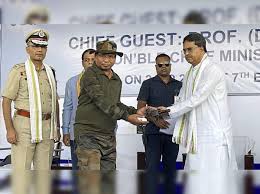TRIPURA'S INSURGENCY RESOLUTION: A LANDMARK DECLARATION

- 25 Sep 2024
In News:
Recent Developments
Insurgency-Free Declaration
Tripura Chief Minister Manik Saha has officially declared the state "insurgency-free" following a significant surrender ceremony where 584 militants from the National Liberation Front of Tripura (NLFT) and the All-Tripura Tiger Force (ATTF) laid down their arms.
Memorandum of Settlement
This milestone follows a Memorandum of Settlement signed on September 4 between the central government and various insurgent groups, witnessed by the union home minister. The Tripura government has successfully facilitated 12 peace accords over the last decade, leading to over 10,000 insurgents surrendering.
Understanding Insurgency in Tripura
Historical Context
Tribal Composition
Tripura is home to 19 indigenous tribes, including the Tripra, Reang, and Jamatia, with Kok Borok as the primary language alongside other Tibeto-Burmese dialects.
Journey to Statehood
- Accession: Tripura became part of the Indian Union on October 15, 1949.
- Union Territory: It was designated as a Union Territory on November 1, 1956.
- Statehood: Tripura attained full statehood on January 21, 1972.
Causes of Insurgency
- Demographic Changes: A significant influx of Bengali refugees from East Pakistan resulted in the indigenous population declining from 95% in 1931 to 31% by 1991.
- Tribal Discontent: The tribal population lost control over land and resources, leading to widespread grievances.
- Socio-Economic Factors: Issues such as geographic isolation, socio-economic challenges, corruption, and tribal land alienation fueled unrest.
Evolution of Political Movements and Insurgency
Formation of Political Organizations
- TUJS: Established in 1967 to advocate for tribal rights and autonomy.
- Armed Struggle: The Tripura Sena emerged in 1970, followed by the Tripura National Volunteers (TNV) in 1978, both pushing for an independent tribal state.
Rise of Insurgent Groups
Key groups involved include:
- TUJS: Formed in 1971.
- TNV: Established in 1981.
- NLFT: Founded in 1989.
- ATTF: Formed in 1990.
Communal Clashes and Military Response
- Opposition from Bengali Population: Groups like Amra Bangali emerged in opposition to tribal demands, leading to violent clashes with over 1,800 fatalities.
- Military Intervention: The Indian Army was deployed in 1980 to restore order.
Attempts at Peace and Resurgence of Militancy
TNV Settlement
The TNV signed a peace agreement with the state government in 1988, focusing on restoring tribal lands. However, issues with implementation led to the rise of new militant groups.
Resurgence of Insurgency
Between 1996 and 2004, insurgency gained traction, supported by logistics from Bangladesh and external networks, leveraging the region's challenging geography.
Strategic Response to Insurgency
- Counter-Insurgency Operations
- The state focused on effective counter-insurgency operations involving local police and paramilitary forces, minimizing the need for military deployment.
- Psychological Operations
- Efforts were made to shift perceptions among tribal communities, exposing the exploitative nature of insurgents.
- Confidence-Building Measures
- Rehabilitation packages and public appeals by state leaders encouraged insurgents to reintegrate into society.
- Civic and Developmental Initiatives
- Comprehensive development initiatives were implemented, enhancing healthcare, connectivity, and job opportunities, alongside civic action programs by security forces.
- Political and Governance Reforms
- Strengthening local governance through autonomous councils and encouraging tribal participation aimed to foster a more inclusive development process.
Conclusion
Tripura's journey to overcome insurgency highlights the effectiveness of a multi-faceted approach, combining socio-economic development with strategic military and political initiatives. The state's experience illustrates that insurgency can be addressed through sincere leadership and a balanced focus on military and socio-economic challenges.
